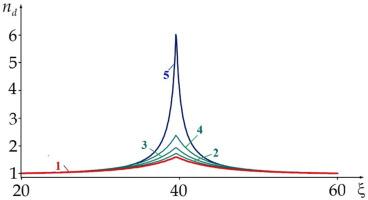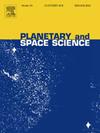非理想尘埃组分行星等离子体中尘埃声波的非线性理论
IF 1.7
4区 物理与天体物理
Q3 ASTRONOMY & ASTROPHYSICS
引用次数: 0
摘要
考虑了一种非理想尘埃行星等离子体,它由三种气体的混合物组成——无惯性电子和离子气体,以及带负电荷的尘埃粒子气体。等离子体中的电子和离子被认为是玻尔兹曼分布的,尘埃气体符合Avinash先前推导出的非理想气体的状态方程。首次对等离子体中的静止尘埃声波进行了研究。研究是在气体动力学方法下进行的。建立了粉尘声的线性理论,在此基础上推导了粉尘声的色散方程,得到了粉尘声线速度的精确表达式。基于伯努利赝势方法,首次提出了非理想尘埃等离子体中大振幅daw的非线性理论。赝势分析表明,等离子体中的稳态daw既可以具有非线性周期波的形式,也可以具有孤子形式。定义了这两种形式的波速范围。计算了da孤子的最大速度和最大马赫数与非理想参数值的关系。随着非理想参数的增大,极端孤子的振幅减小,其半极大值宽度实际上与该参数无关。发展的理论可以用来描述出现在行星及其卫星和彗星附近的致密非理想等离子体中的daw。本文章由计算机程序翻译,如有差异,请以英文原文为准。

Nonlinear theory of dust-acoustic waves in planetary plasmas with non-ideal dust fraction
A non-ideal dusty planetary plasma was considered, consisting of a mixture of three gases – gases of inertialess electrons and ions, and a gas of negatively charged dust particles. Electrons and ions in the plasma were thought to be Boltzmann-distributed, and the dust gas obeyed the equation of state of the non-ideal gas previously deduced by Avinash. Stationary dust-acoustic waves DAWs in such plasma were studied for the first time. The study was carried out in the gas dynamic approach.
The linear theory of DAWs has been developed, within the framework of which a dispersion equation was derived and an exact expression for the linear velocity of a dust sound was obtained.
The non-linear theory of large amplitude DAWs in a non-ideal dust plasma based on the Bernoulli pseudopotential method was first developed. Pseudopotential analysis showed that stationary DAWs in the considered plasma can have the form of either a nonlinear periodic wave or the form of solitons. The wave velocity ranges in these two forms are defined.
The dependence of the maximum velocity of DA-solitons and the maximum Mach number on the value of the parameter of non-ideality is calculated. It was also found that with an increase of the parameter of non-ideality, the amplitude of the extreme soliton decreases, and its width at half-maximum practically does not depend on this parameter.
The developed theory can be used to describe DAWs appearing in dense non-ideal plasmas near planets, their satellites and comets.
求助全文
通过发布文献求助,成功后即可免费获取论文全文。
去求助
来源期刊

Planetary and Space Science
地学天文-天文与天体物理
CiteScore
5.40
自引率
4.20%
发文量
126
审稿时长
15 weeks
期刊介绍:
Planetary and Space Science publishes original articles as well as short communications (letters). Ground-based and space-borne instrumentation and laboratory simulation of solar system processes are included. The following fields of planetary and solar system research are covered:
• Celestial mechanics, including dynamical evolution of the solar system, gravitational captures and resonances, relativistic effects, tracking and dynamics
• Cosmochemistry and origin, including all aspects of the formation and initial physical and chemical evolution of the solar system
• Terrestrial planets and satellites, including the physics of the interiors, geology and morphology of the surfaces, tectonics, mineralogy and dating
• Outer planets and satellites, including formation and evolution, remote sensing at all wavelengths and in situ measurements
• Planetary atmospheres, including formation and evolution, circulation and meteorology, boundary layers, remote sensing and laboratory simulation
• Planetary magnetospheres and ionospheres, including origin of magnetic fields, magnetospheric plasma and radiation belts, and their interaction with the sun, the solar wind and satellites
• Small bodies, dust and rings, including asteroids, comets and zodiacal light and their interaction with the solar radiation and the solar wind
• Exobiology, including origin of life, detection of planetary ecosystems and pre-biological phenomena in the solar system and laboratory simulations
• Extrasolar systems, including the detection and/or the detectability of exoplanets and planetary systems, their formation and evolution, the physical and chemical properties of the exoplanets
• History of planetary and space research
 求助内容:
求助内容: 应助结果提醒方式:
应助结果提醒方式:


